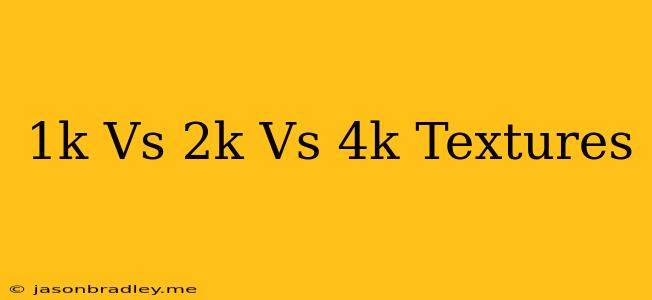The World of Textures: 1K, 2K, 4K, and Beyond
In the world of digital art and 3D modeling, textures are the lifeblood that brings objects to life. They add detail, realism, and a sense of depth that elevates our creations to a whole new level. But how do we choose the right texture resolution for our projects?
This article will explore the differences between 1K, 2K, and 4K textures, helping you understand their implications and make informed decisions for your work.
What is a Texture?
A texture is a digital image that is applied to a 3D model's surface. These images contain information about the model's appearance, such as its color, surface properties, and even its bumpiness.
Understanding Resolution
The number "K" in 1K, 2K, and 4K refers to the resolution of the texture. It indicates the number of pixels along one dimension of the image.
- 1K (1024x1024 pixels)
- 2K (2048x2048 pixels)
- 4K (4096x4096 pixels)
The Higher the Resolution, the More Detail
The main difference between these resolutions lies in the level of detail they offer.
- 1K textures are suitable for low-poly models or projects where visual detail is not a top priority.
- 2K textures provide a significant improvement in detail, making them ideal for mid-range models and projects that require more realistic visuals.
- 4K textures are the highest resolution option, offering an immense amount of detail. They are often used for high-poly models and projects demanding exceptional visual fidelity.
Choosing the Right Texture Resolution
The ideal texture resolution depends on several factors:
- Model complexity: More complex models require higher resolution textures to maintain detail.
- Project scope: For large-scale projects or those demanding photorealism, higher resolution textures are essential.
- Performance limitations: High-resolution textures can be demanding on your system's resources. It's essential to consider performance limitations and strike a balance between detail and efficiency.
- Desired aesthetic: The desired aesthetic of your project will also play a role. If you aim for a stylized look, lower resolution textures might be sufficient.
Beyond 4K
While 4K is the current standard for high-quality textures, newer technologies are pushing the boundaries even further. 8K and 16K textures are becoming increasingly common, offering an even more realistic and detailed experience.
Conclusion
Choosing the right texture resolution is crucial for creating stunning and realistic visuals. Understanding the differences between 1K, 2K, and 4K textures allows you to make informed decisions that optimize your workflow, performance, and visual fidelity. Remember to consider your project's needs, target platform, and available resources when selecting the appropriate texture resolution.
